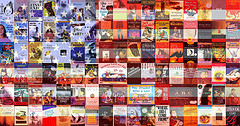 What do Nickel and Dimed: On (Not) Getting by in America, Brave New World, and Revolutionary Voices have in common with Twilight, And Tango Makes Three, and The Hunger Games? All of them made a Top Ten list. No, not David Letterman’s Top Ten List. Instead, they made the American Library Association’s list of most frequently challenged books in 2010.
What do Nickel and Dimed: On (Not) Getting by in America, Brave New World, and Revolutionary Voices have in common with Twilight, And Tango Makes Three, and The Hunger Games? All of them made a Top Ten list. No, not David Letterman’s Top Ten List. Instead, they made the American Library Association’s list of most frequently challenged books in 2010.
Almost 30 years old, Banned Books Week takes place the last week in September (September 24-October 1, 2011) and celebrates the freedom to read. The American Library Association’s Office for Intellectual Freedom keeps a “challenge database” of challenges by year, reason, initiator, and institution. Leading the challenges by institution? Schools, followed by school libraries. Most challenged author? Judy Blume.
To me, Banned Books Week reminds me a little of International Women’s Day or African American History Month—it highlights an issue we should be mindful of for more than a day, a week, or a month. But, it gets that issue out at the beginning of the school year, reminding us that many banned and challenged books are classics. Our educations would have been the poorer had they been banned at our schools. Bans and challenges aren’t confined to classics either. J.K. Rowling finds herself keeping company with John Steinbeck and Mark Twain, proving that the 21st century isn’t immune from book challenges.
How will you mark Banned Books Week? Personally, I’m working my way through Harry Potter and am currently in Harry’s fifth year. Thanks to the wonderful world of the interwebs, you can read a banned book with pride, for all the world to see.
